The EU precious metal plating chemicals industry is valued at USD 572.9 million in 2025 and is projected to reach USD 856.2 million by 2035, recording an absolute increase of USD 283.3 million. This growth trajectory translates into a CAGR of 4.1%, supported by expanding end uses across electronics, automotive, aerospace, medical devices, and decorative applications. Historical demand has been shaped by the miniaturization of electronic components, the need for enhanced conductivity in industrial parts, and rising preference for aesthetic finishes in luxury goods. Forecast expansion is expected to accelerate as automotive electrification and EU regulatory standards for corrosion resistance continue to reshape demand patterns. The value outlook highlights that higher purity formulations and low waste plating systems will capture stronger price premiums compared to general industrial grades.
Demand is particularly concentrated in electronics manufacturing, where gold and palladium plating enhance circuit board reliability, microchip performance, and semiconductor durability. The automotive industry is also contributing to stronger adoption as electric vehicles create new requirements for battery connectors, charging pins, and electronic modules. Medical devices and implants are another growth frontier, where platinum and gold coatings are valued for their biocompatibility and corrosion resistance. Decorative coatings in watches, jewelry, and luxury accessories maintain a steady base, providing resilience against cyclical downturns. From a supply side, formulators are focusing on longer bath life, reduced drag-out losses, and compatibility with advanced substrates, which are central to lowering operational costs for end users.
Comparative growth against substitutes shows mixed trends. Base metal coatings, such as nickel or copper alloys, are widely used where cost sensitivity dominates, but their limited conductivity and weaker corrosion protection reduce adoption in critical applications. Bioplastics and protein-based coatings have been explored in niche segments of decorative finishes, yet they lack the performance stability of precious metals. Advanced alloy coatings provide partial substitution in non-critical connectors, but stringent EU performance and safety standards preserve demand for precious metal systems. Environmental pressures have also accelerated a shift from legacy cyanide-based gold baths toward alternative chemistries with lower environmental impact, placing emphasis on R&D-driven solutions. Companies with proven recycling systems and closed-loop recovery processes are expected to gain preference as brand owners increasingly scrutinize supply chain transparency.
Risks to growth lie in precious metal price volatility, with gold, platinum, and palladium showing strong swings that can influence input costs. Suppliers are mitigating this through hedging practices, sourcing diversification, and integration of advanced recovery units at plating facilities. Long qualification cycles at major automotive and electronics clients also pose barriers to rapid adoption, requiring suppliers to demonstrate technical support, certification, and compliance evidence. Future competitiveness will be defined by efficiency in chemical usage, low environmental footprint, and integration with automated plating lines between 2025 and 2030.
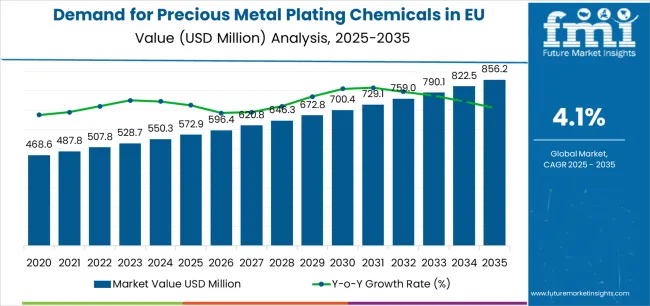
| Metric | Value |
|---|---|
| Estimated Value in (2025E) | USD 572.9 million |
| Forecast Value in (2035F) | USD 856.2 million |
| Forecast CAGR (2025 to 2035) | 4.1% |
Between 2025 and 2030, EU precious metal plating chemicals demand is projected to expand from USD 572.9 million to USD 701.3 million, resulting in a value increase of USD 128.4 million, which represents 45.2% of the total forecast growth for the decade. This phase of development will be shaped by ongoing electronics manufacturing requiring reliable contact plating, expanding automotive electronics necessitating corrosion-resistant coatings, and growing medical device production demanding biocompatible precious metal finishes. Manufacturers are adapting their product formulations to address evolving requirements for improved throwing power characteristics, enhanced bath stability specifications, and specialized chemistries suitable for semiconductor packaging, automotive connector applications, and implantable medical device coatings.
From 2030 to 2035, sales are forecast to grow from USD 701.3 million to USD 856.2 million, adding another USD 155.5 million, which constitutes 54.8% of the overall ten-year expansion. This period is expected to be characterized by continued integration of advanced formulations supporting miniaturized electronics, expansion of palladium-based systems for automotive applications, and sustained demand from aerospace and defense sectors requiring high-reliability coatings. The growing emphasis on regulatory compliance and increasing requirements for environmentally compliant electroplating chemistries will drive demand for precious metal plating chemicals that deliver consistent performance across demanding electronics assembly, automotive manufacturing, and medical device production while meeting REACH regulations and wastewater treatment standards.
Between 2020 and 2025, EU precious metal plating chemicals sales experienced steady expansion at a CAGR of 3.4%, growing from USD 483.7 million to USD 572.9 million. This period was driven by resilient demand from electronics manufacturing requiring contact surfaces and interconnections, ongoing automotive production utilizing precious metal coatings for sensors and connectors, and stable jewelry sector consumption. The industry developed as European plating companies maintained reliable procurement patterns while specialty chemical suppliers enhanced their capabilities to deliver high-purity formulations, cyanide-free alternatives, and application-optimized chemistries meeting stringent quality and environmental requirements.
Industry expansion is being supported by the critical functional requirements for precious metal coatings across electronics applications and the corresponding demand for reliable, high-performance electroplating chemistries delivering superior electrical conductivity, exceptional corrosion resistance, and proven wire-bonding compatibility essential for semiconductor packaging and electronic component manufacturing. Modern electronics assemblers and connector manufacturers rely on precious metal plating chemicals as essential surface finishing materials for contact surfaces requiring low electrical resistance, wire-bonding pads demanding reliable metallurgical bonding, and corrosion protection necessitating stable noble metal coatings, driving demand for chemistries that consistently deliver required deposit properties, bath stability characteristics, and process reliability necessary for high-volume production and stringent quality specifications. Even modest variations in plating chemistry performance, including throwing power, deposit hardness, or bath contaminant sensitivity, can significantly impact production yield and product reliability across critical electronics and automotive applications.
The growing requirements for environmentally compliant plating processes and increasing recognition of cyanide-free formulation advantages for worker safety and wastewater treatment are driving demand from plating operations with appropriate environmental permits and validated process controls. Regulatory authorities are increasingly establishing clear guidelines for electroplating wastewater discharge, hazardous chemical handling requirements, and occupational exposure limits to maintain environmental compliance and ensure worker safety. Technical research and commercial validation studies are providing evidence supporting advanced precious metal plating chemistries including sulfite-based gold systems, pyrophosphate formulations, and additive packages optimizing deposit properties, requiring specialized chemical synthesis capabilities and standardized quality control protocols for optimal bath performance, appropriate deposit characteristics, and consistent process reliability supporting demanding electronics, automotive, and medical device manufacturing applications.
Sales are segmented by product type (chemical base metal), application, distribution channel, nature (product form), and country. By product type (chemical base metal), demand is divided into gold plating chemicals, palladium, rhodium, silver, platinum, and others. Based on application, sales are categorized into electrical and electronics, jewelry and luxury, automotive, aerospace and defense, medical devices, and hardware and other industrial. In terms of distribution channel, demand is segmented into direct to OEM, specialty distributors, and online channels. By nature (product form), sales are classified into solutions/concentrates and solid/powder. Regionally, demand is focused on Germany, France, Italy, Spain, the Netherlands, and the Rest of Europe.
.webp)
The gold plating chemicals segment is projected to account for 33% of EU precious metal plating chemicals sales in 2025, declining slightly to 32% by 2035, establishing itself as the dominant chemical type across European industries. This commanding position is fundamentally supported by gold plating's essential role in electronics contact surfaces requiring low electrical resistance, wire-bonding applications demanding reliable metallurgical bonding to gold wires, and corrosion protection providing long-term stability in demanding environments. The gold plating format delivers exceptional versatility, providing electronics manufacturers, connector producers, and semiconductor packaging operations with high-performance coatings that facilitate reliable electrical connections, stable surface properties, and proven compatibility with downstream assembly processes.
This segment benefits from established formulation technologies including cyanide-based systems delivering excellent throwing power, sulfite-based alternatives offering improved environmental profiles, and specialty additives optimizing deposit hardness and appearance. Additionally, gold plating chemicals offer performance advantages across critical applications, including semiconductor lead frames requiring wire-bondable surfaces, connector contacts demanding low contact resistance and corrosion protection, and printed circuit board edge connectors necessitating durable gold finishes preventing oxidation.
The gold plating chemicals segment is expected to decline slightly to 32.0% share by 2035, demonstrating modest erosion as palladium-based systems capture incrementally larger shares through automotive applications and cost-competitive alternatives gain acceptance in specific electronics applications throughout the forecast period.
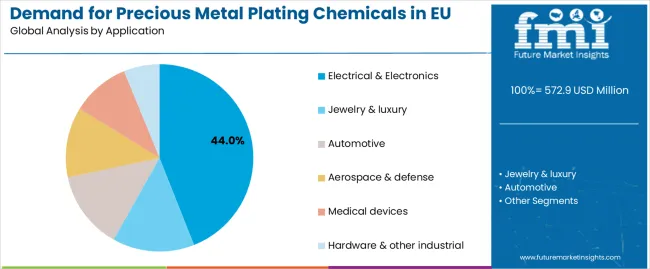
Electrical and electronics applications are positioned to represent 44% of total precious metal plating chemicals demand across European industries in 2025, expanding to 45% by 2035, reflecting the segment's dominant position as the primary application within the overall industry ecosystem. This substantial share directly demonstrates that electronics manufacturing represents the largest single application sector, with semiconductor packaging operations, connector manufacturers, printed circuit board fabricators, and electronic component producers utilizing precious metal plating for contact surfaces, wire-bonding pads, and corrosion-resistant coatings essential for electronic device reliability and performance.
Modern electronics manufacturers increasingly rely on precious metal plating delivering controlled deposit thickness for miniaturized components, appropriate hardness for connector insertion durability, and excellent corrosion resistance protecting electronic assemblies during service life. The segment benefits from continuous technology advancement focused on improving plating uniformity for high-aspect-ratio features, developing selective plating processes reducing precious metal consumption, and optimizing chemistries supporting advanced packaging technologies including flip-chip and wafer-level packaging.
The segment's expanding share reflects growing electronics content in automotive applications, increasing miniaturization driving precious metal usage in advanced packaging, and expanding semiconductor manufacturing capacity supporting European electronics production throughout the forecast period.
EU precious metal plating chemicals sales are advancing steadily due to ongoing electronics manufacturing demand, increasing automotive electronics content, and growing medical device production. However, the industry faces challenges, including precious metal price volatility affecting economics, tightening REACH and cyanide regulations requiring formulation changes, and potential substitution by base metal alternatives in cost-sensitive applications. Continued focus on cyanide-free formulation development, process optimization reducing precious metal consumption, and regulatory compliance support remains central to industry development.
The gradually accelerating development of cyanide-free precious metal plating chemistries is systematically transforming European electroplating operations from traditional cyanide-based systems to environmentally preferable alternatives, addressing regulatory pressure, worker safety concerns, and wastewater treatment complexity. Advanced cyanide-free formulations featuring sulfite-based gold plating systems, pyrophosphate complexes, and specialty additives delivering performance approaching cyanide chemistry enable plating operations to eliminate hazardous cyanide handling while maintaining deposit quality and process economics. These alternative chemistries prove particularly valuable for electronics applications where environmental compliance and worker safety drive technology transitions, and for smaller plating operations where cyanide wastewater treatment proves economically challenging.
Modern electronics manufacturers systematically incorporate selective plating technologies including pattern plating through photoresists, localized brush plating, and laser-activated selective deposition reducing precious metal consumption while maintaining functional performance where required. Strategic integration of selective deposition methods, including photolithographic pattern definition limiting plating to contact areas, pulse plating protocols optimizing deposit properties at reduced thickness, and engineered underplates substituting thick precious metal deposits with thin functional layers enable manufacturers to reduce precious metal costs while meeting electrical and reliability requirements. These conservation technologies prove essential for cost-sensitive applications including consumer electronics, automotive connectors, and telecommunications equipment where precious metal economics significantly impact component costs and competitive positioning.
European electroplating operations increasingly prioritize comprehensive environmental compliance programs addressing REACH chemical registration, wastewater discharge permits, and occupational exposure limits requiring systematic chemical management, treatment technology investment, and documentation supporting regulatory audits. This regulatory focus enables plating chemistry suppliers to differentiate offerings through REACH-compliant formulations eliminating restricted substances, technical documentation supporting discharge permitting, and analytical services helping customers maintain compliance. Environmental compliance proves particularly important for plating operations serving regulated industries including medical devices, aerospace components, and automotive applications where customer audits verify environmental management systems and regulatory compliance as supplier qualification requirements.
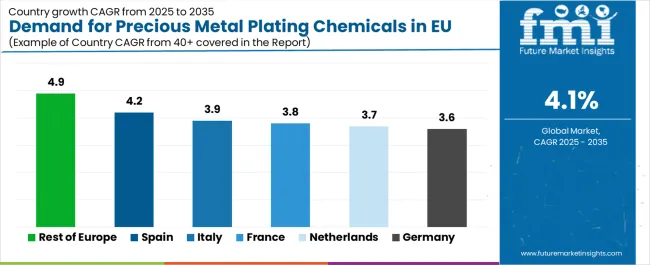
| Country | CAGR % |
|---|---|
| Rest of Europe | 4.9% |
| Spain | 4.2% |
| Italy | 3.9% |
| France | 3.8% |
| Netherlands | 3.7% |
| Germany | 3.6% |
EU precious metal plating chemicals sales demonstrate varied growth across major European economies, with the Rest of Europe leading expansion at 4.9% CAGR through 2035, driven by expanding electronics manufacturing and growing industrial base. Spain maintains strong positioning through automotive sector development and electronics growth. Italy benefits from luxury goods manufacturing and diversified industrial applications. France leverages aerospace industry presence and automotive sector. Netherlands demonstrates steady advancement reflecting electronics concentration and chemical distribution expertise. Germany maintains consistent growth through established electronics manufacturing and automotive sector. Overall, sales show stable regional development reflecting sustained electronics demand and ongoing automotive electronics expansion across EU industries.
Revenue from precious metal plating chemicals in Germany is projected to exhibit steady growth with a CAGR of 3.6% through 2035, driven by Europe's largest electronics manufacturing sector, substantial automotive industry requiring connector and sensor coatings, and diversified industrial base utilizing precious metal finishes across mechanical components and tooling. Germany's internationally recognized manufacturing capabilities and established electroplating infrastructure are creating sustained demand for precious metal plating chemicals across electronics, automotive, and industrial applications.
Major electronics manufacturers, automotive suppliers operating in-house plating lines, medical device companies, and industrial plating job shops source precious metal plating chemicals from domestic suppliers including Heraeus operations and European specialty chemical companies ensuring quality consistency. German demand benefits from substantial semiconductor packaging and assembly operations, comprehensive automotive electronics supply chain, and precision engineering sectors utilizing precious metal coatings for specialized applications.
Revenue from precious metal plating chemicals in France is expanding at a CAGR of 3.8%, substantially supported by substantial aerospace and defense industry requiring high-reliability coatings, automotive sector utilizing precious metals for sensors and connectors, and luxury goods manufacturing including watches and jewelry. France's diversified industrial structure and aerospace sector prominence are systematically driving stable precious metal plating chemicals demand across multiple application sectors.
Major aerospace contractors, automotive suppliers, luxury goods manufacturers, and electronics companies source precious metal plating chemicals from European suppliers ensuring regulatory compliance and quality specifications. French demand particularly benefits from aerospace industry presence requiring corrosion-resistant precious metal coatings for critical components, automotive sector development, and luxury goods manufacturing tradition supporting jewelry and watch production utilizing precious metal finishes.
Revenue from precious metal plating chemicals in Italy is growing at a robust CAGR of 3.9%, fundamentally driven by substantial jewelry and luxury goods manufacturing sector, diversified electronics production, and automotive component manufacturing utilizing precious metal coatings. Italy's traditional jewelry industry and broad manufacturing base are supporting sustained precious metal plating chemicals demand across luxury goods and industrial applications.
Major jewelry manufacturers concentrated in Arezzo and Vicenza districts, electronics producers, automotive suppliers, and industrial plating operations source precious metal plating chemicals from European suppliers ensuring quality specifications. Italian demand particularly benefits from substantial jewelry sector utilizing gold and rhodium plating for finishing, fashion accessories production, and diversified manufacturing base including electronics and automotive components requiring functional precious metal coatings.
Demand for precious metal plating chemicals in Spain is projected to grow at a CAGR of 4.2%, substantially supported by expanding automotive manufacturing sector, growing electronics production, and increasing medical device manufacturing. Spanish industrial development and manufacturing sector expansion are positioning precious metal plating chemicals as essential specialty chemicals across growing application sectors.
Major automotive suppliers, electronics manufacturers, medical device producers, and industrial plating operations source precious metal plating chemicals from European suppliers ensuring regulatory compliance. Spanish demand benefits from automotive sector expansion requiring connector and sensor coatings, electronics manufacturing growth, and emerging medical device production sector utilizing precious metal coatings for implantable devices and surgical instruments.
Demand for precious metal plating chemicals in the Netherlands is expanding at a CAGR of 3.7%, fundamentally driven by concentrated electronics manufacturing sector, specialty chemical distribution infrastructure, and medical device production. Dutch electronics concentration and chemical industry expertise are creating focused precious metal plating chemicals demand supporting both domestic consumption and European distribution.
Netherlands demand significantly benefits from electronics manufacturing operations including semiconductor packaging activities, medical device production requiring precious metal coatings, and specialty chemical distribution networks serving European plating operations. The country's electronics and chemical industry concentration creates substantial precious metal plating chemicals consumption and distribution activities supporting regional supply chains.
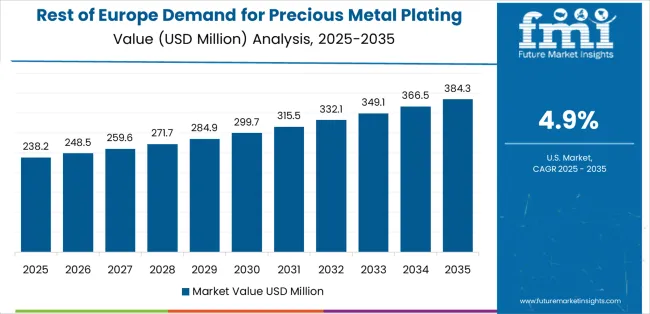
Revenue from precious metal plating chemicals in the Rest of Europe region is expanding at a CAGR of 4.9%, substantially supported by expanding electronics manufacturing capacity, growing automotive electronics production, and increasing medical device sector development across diverse European industries outside major economies. Regional industrial development and electronics manufacturing expansion are creating sustained precious metal plating chemicals demand across varied applications.
Industrial consumers across Rest of Europe industries, including electronics manufacturers, automotive suppliers, medical device producers, and plating job shops, source precious metal plating chemicals from European suppliers and specialty distributors. Rest of Europe demand reflects expanding electronics contract manufacturing, automotive electronics content growth, and medical device sector development across various industries creating increased precious metal plating requirements.
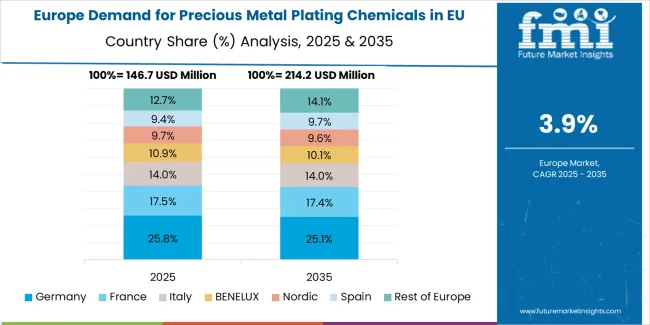
EU precious metal plating chemicals sales are projected to grow from USD 572.9 million in 2025 to USD 856.2 million by 2035, registering a CAGR of 4.1% over the forecast period. The Rest of Europe region is expected to demonstrate the strongest growth trajectory with a 4.9% CAGR, supported by expanding electronics manufacturing, growing medical device production, and increasing automotive electronics content. Spain follows with a 4.2% CAGR, attributed to automotive sector development and electronics manufacturing expansion.
Italy demonstrates 3.9% CAGR, reflecting jewelry sector presence and diversified manufacturing. France shows 3.8% CAGR, supported by aerospace and automotive applications. Netherlands exhibits 3.7% CAGR, driven by electronics sector and specialty chemical distribution. Germany demonstrates 3.6% CAGR, reflecting mature market characteristics and established electronics manufacturing.
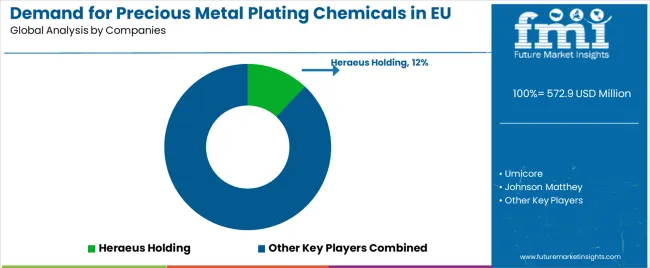
EU precious metal plating chemicals sales are defined by competition among precious metal refiners with chemical divisions, specialty electroplating chemistry suppliers, and regional chemical manufacturers serving electronics, automotive, and industrial plating industries. Companies are investing in cyanide-free formulation development, process chemistry optimization reducing precious metal consumption, analytical and technical service capabilities, and regulatory compliance support to deliver reliable, high-performance, and environmentally compliant precious metal plating chemistry solutions. Strategic relationships with major electronics manufacturers and automotive suppliers, technical service programs supporting process optimization, and precious metal refining and recycling integration supporting circular material flows are central to strengthening market position.
Major participants include Heraeus Holding with an estimated 12.0% share, leveraging its integrated precious metal refining operations, comprehensive electroplating chemistry portfolio, and European manufacturing presence. Heraeus benefits from precious metal refining expertise ensuring raw material supply security, technical development capabilities supporting advanced formulation development, and established relationships with electronics and automotive customers.
Umicore holds approximately 9.5% share, emphasizing its precious metal refining and recycling capabilities, catalyst technology expertise translatable to plating chemistry additives, and European production footprint. Umicore's success in serving automotive and electronics applications through integrated precious metal management and technical innovation creates competitive positioning, supported by refining operations and specialty chemistry expertise.
Johnson Matthey accounts for roughly 7.5% share through its position as a precious metal specialist, providing plating chemistries alongside refining and catalytic materials serving electronics, medical device, and industrial applications. The company benefits from precious metal expertise, established electronics industry relationships particularly for semiconductor packaging, and medical device sector knowledge supporting biocompatible coating development.
Metalor Technologies (Tanaka) represents approximately 6.0% share, supporting growth through Swiss watch industry relationships, jewelry sector expertise, and precious metal refining integration. Metalor leverages watch and jewelry industry connections, European luxury goods manufacturing presence, and technical expertise supporting decorative and functional plating applications.
Technic Inc. accounts for approximately 4.5% share through semiconductor packaging chemistry specialization, advanced electronics coating formulations, and technical service supporting leading-edge applications. Technic benefits from semiconductor industry relationships, advanced packaging technology expertise, and innovation capabilities supporting miniaturized electronics coating requirements. Other companies and regional suppliers collectively hold 60.5% share, reflecting the moderately fragmented nature of European precious metal plating chemicals sales.
| Item | Value |
|---|---|
| Quantitative Units | USD 856.2 million |
| Product Type (Chemical Base Metal) | Gold plating chemicals, Palladium, Rhodium, Silver, Platinum, Others |
| Application | Electrical & Electronics, Jewelry & luxury, Automotive, Aerospace & defense, Medical devices, Hardware & other industrial |
| Distribution Channel | Direct to OEM, Specialty Distributors, Online |
| Nature (Product Form) | Solutions/Concentrates, Solid/Powder |
| Forecast Period | 2025-2035 |
| Base Year | 2025 |
| Historical Data | 2020-2024 |
| Countries Covered | Germany, France, Italy, Spain, the Netherlands, and the Rest of Europe |
| Key Companies Profiled | Heraeus Holding, Umicore, Johnson Matthey, Metalor Technologies, Technic Inc., Regional suppliers |
| Report Pages | 180+ Pages |
| Data Tables | 50+ Tables and Figures |
| Additional Attributes | Dollar sales by product type (chemical base metal), application, distribution channel, nature (product form), and country; regional demand trends across major European industries; competitive landscape analysis with established precious metal refiners and specialty chemistry suppliers; electronics manufacturer and plating operation preferences for various chemistry types and formulations; integration with semiconductor packaging, connector manufacturing, automotive electronics, and medical device production; innovations in cyanide-free formulations, selective plating technologies, and environmental compliance; adoption across direct OEM procurement and specialty distributor channels. |
The global demand for precious metal plating chemicals in eu is estimated to be valued at USD 572.9 million in 2025.
The market size for the demand for precious metal plating chemicals in eu is projected to reach USD 856.2 million by 2035.
The demand for precious metal plating chemicals in eu is expected to grow at a 4.1% CAGR between 2025 and 2035.
The key product types in demand for precious metal plating chemicals in eu are gold plating chemicals, palladium, rhodium, silver, platinum and others.
In terms of application, electrical & electronics segment to command 44.0% share in the demand for precious metal plating chemicals in eu in 2025.






Our Research Products

The "Full Research Suite" delivers actionable market intel, deep dives on markets or technologies, so clients act faster, cut risk, and unlock growth.

The Leaderboard benchmarks and ranks top vendors, classifying them as Established Leaders, Leading Challengers, or Disruptors & Challengers.

Locates where complements amplify value and substitutes erode it, forecasting net impact by horizon

We deliver granular, decision-grade intel: market sizing, 5-year forecasts, pricing, adoption, usage, revenue, and operational KPIs—plus competitor tracking, regulation, and value chains—across 60 countries broadly.

Spot the shifts before they hit your P&L. We track inflection points, adoption curves, pricing moves, and ecosystem plays to show where demand is heading, why it is changing, and what to do next across high-growth markets and disruptive tech

Real-time reads of user behavior. We track shifting priorities, perceptions of today’s and next-gen services, and provider experience, then pace how fast tech moves from trial to adoption, blending buyer, consumer, and channel inputs with social signals (#WhySwitch, #UX).

Partner with our analyst team to build a custom report designed around your business priorities. From analysing market trends to assessing competitors or crafting bespoke datasets, we tailor insights to your needs.
Supplier Intelligence
Discovery & Profiling
Capacity & Footprint
Performance & Risk
Compliance & Governance
Commercial Readiness
Who Supplies Whom
Scorecards & Shortlists
Playbooks & Docs
Category Intelligence
Definition & Scope
Demand & Use Cases
Cost Drivers
Market Structure
Supply Chain Map
Trade & Policy
Operating Norms
Deliverables
Buyer Intelligence
Account Basics
Spend & Scope
Procurement Model
Vendor Requirements
Terms & Policies
Entry Strategy
Pain Points & Triggers
Outputs
Pricing Analysis
Benchmarks
Trends
Should-Cost
Indexation
Landed Cost
Commercial Terms
Deliverables
Brand Analysis
Positioning & Value Prop
Share & Presence
Customer Evidence
Go-to-Market
Digital & Reputation
Compliance & Trust
KPIs & Gaps
Outputs
Full Research Suite comprises of:
Market outlook & trends analysis
Interviews & case studies
Strategic recommendations
Vendor profiles & capabilities analysis
5-year forecasts
8 regions and 60+ country-level data splits
Market segment data splits
12 months of continuous data updates
DELIVERED AS:
PDF EXCEL ONLINE
Precious Metal Plating Chemicals Market Size and Share Forecast Outlook 2025 to 2035
Demand for Electroplating Chemicals in EU Size and Share Forecast Outlook 2025 to 2035
Precious Metal Beneficiation Reagents Market Size and Share Forecast Outlook 2025 to 2035
Precious Metal Nano Wires Market Size and Share Forecast Outlook 2025 to 2035
Gold Plating Chemicals Market Growth – Trends & Forecast 2025 to 2035
Prinzmetal Angina Therapeutics Market – Innovations & Future Trends 2025 to 2035
Functional Plating Chemicals Market Size and Share Forecast Outlook 2025 to 2035
Eco-friendly Precious Metal Beneficiation Reagents Market Forecast and Outlook 2025 to 2035
Metal Food Can Industry Analysis in Europe Insights - Growth & Forecast 2025 to 2035
Non-eco-friendly Precious Metal Beneficiation Reagents Market Forecast and Outlook 2025 to 2035
Metallurgical Lighting Market Size and Share Forecast Outlook 2025 to 2035
Metal Evaporation Boat Market Size and Share Forecast Outlook 2025 to 2035
Metal Miniature Bone Plates Market Size and Share Forecast Outlook 2025 to 2035
Metal Locking Plate and Screw System Market Size and Share Forecast Outlook 2025 to 2035
Europe Radiotherapy Patient Positioning Market Size and Share Forecast Outlook 2025 to 2035
Metal Pallet Market Size and Share Forecast Outlook 2025 to 2035
Metal Oxide Varistor (MOV) Surge Arresters Market Size and Share Forecast Outlook 2025 to 2035
Europe Polyvinyl Alcohol Industry Analysis Size and Share Forecast Outlook 2025 to 2035
Metal Straw Market Size and Share Forecast Outlook 2025 to 2035
Metal Can Market Size and Share Forecast Outlook 2025 to 2035

Thank you!
You will receive an email from our Business Development Manager. Please be sure to check your SPAM/JUNK folder too.
Chat With
MaRIA